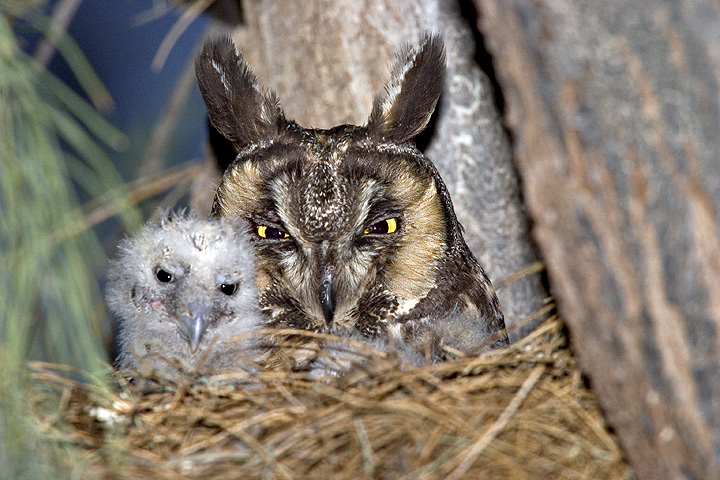
Owls: Nurturing Guardians of the Night
In the realm of avian parenting, owls stand out as exemplary caregivers, exhibiting remarkable dedication and tenderness towards their young. These nocturnal hunters, renowned for their keen eyesight and silent flight, display an equally impressive array of nurturing behaviors that ensure the survival and well-being of their offspring.
Nest Building: A Haven for the Young
The first step in an owl’s parental journey is the construction of a secure and comfortable nest. Owls typically choose secluded locations, such as tree cavities, abandoned nests, or rock crevices, to provide shelter from predators and the elements.
Using their sharp talons and beaks, owls gather materials like twigs, leaves, feathers, and moss to create a cozy and insulated nest. The size and complexity of the nest vary depending on the owl species, but all nests are meticulously designed to provide warmth, protection, and a safe haven for the developing owlets.
Incubation: A Time of Vigilance and Care
Once the nest is complete, the female owl lays her eggs, which are typically white or cream-colored and covered with a protective layer of down. The number of eggs laid varies by species, but most owls lay between two and six eggs.
The female owl assumes the primary responsibility for incubating the eggs, keeping them warm and protected with her body heat. She remains on the nest for extended periods, leaving only briefly to hunt for food. During this time, the male owl often provides support by bringing food to the nest and guarding it from potential threats.
Hatching: A Moment of Triumph
After an incubation period that can last anywhere from 28 to 43 days, depending on the species, the owlets begin to hatch. Using their egg tooth, a small bump on their beak, the owlets break through the eggshell and emerge into the world.
Newly hatched owlets are altricial, meaning they are born helpless and dependent on their parents for food and care. They are covered in soft, downy feathers and have their eyes closed. The female owl continues to brood the owlets, keeping them warm and protected, while the male owl continues to provide food.
Feeding: Nourishing the Growing Young
Owls are carnivorous birds, and their owlets require a steady supply of meat to grow and develop properly. The male owl takes on the primary role of hunting and providing food for the family. He brings back prey such as rodents, birds, and insects to the nest, where the female owl tears it into smaller pieces and feeds it to the owlets.
As the owlets grow older, they begin to learn how to hunt for themselves. The male owl often takes the owlets on hunting trips, teaching them how to locate and capture prey.
Fledging: The Journey to Independence
Around six to eight weeks after hatching, the owlets begin to develop their flight feathers. They start by flapping their wings and hopping around the nest, gradually gaining strength and coordination.
Once the owlets are strong enough to fly, they leave the nest and begin to explore their surroundings. The male and female owls continue to provide support and protection during this transition, teaching the owlets how to hunt and survive on their own.
Sibling Rivalry: A Natural Phenomenon
In some owl species, sibling rivalry can occur, particularly in broods with a large number of owlets. The owlets may compete for food and attention, and in some cases, the weaker owlets may be neglected or even killed by their stronger siblings.
However, sibling rivalry is not always a negative phenomenon. It can help to ensure that only the strongest and fittest owlets survive and reproduce, contributing to the overall health and vitality of the owl population.
Communication: A Symphony of Calls
Owls use a variety of vocalizations to communicate with their young. The female owl often uses a soft, murmuring call to soothe and comfort her owlets. The male owl may use a more aggressive call to warn of potential threats or to defend the nest.
Owlets also communicate with their parents using a variety of calls. They may beg for food, alert their parents to danger, or simply express their contentment.
Parental Investment: A Lifetime Commitment
Owls are long-lived birds, and they often form lifelong pair bonds. Both the male and female owls share the responsibilities of raising their young, and they continue to provide support and protection even after the owlets have become independent.
In some owl species, the parents may continue to feed and care for their young for up to a year after they have fledged. This extended period of parental care helps to ensure that the owlets have the best possible chance of survival and success in the wild.
Conclusion
Owls are remarkable parents, exhibiting a wide range of nurturing behaviors that ensure the survival and well-being of their young. From nest building and incubation to feeding and fledging, owls demonstrate an unwavering commitment to their offspring.
Their dedication and tenderness serve as a testament to the power of parental love and the importance of family bonds in the animal kingdom. By understanding and appreciating the intricate parenting behaviors of owls, we gain a deeper appreciation for the beauty and complexity of nature.
